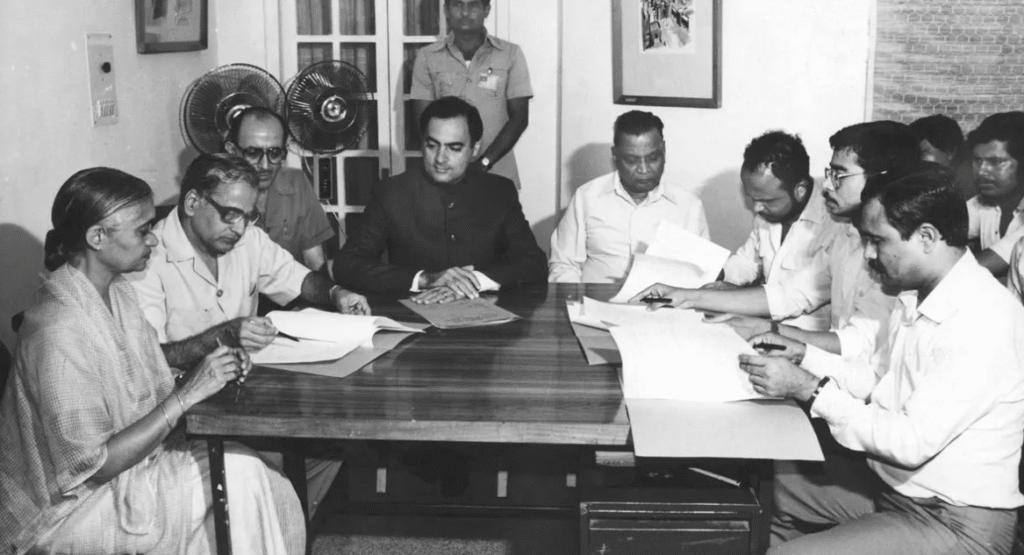“দেশতেই পাওঁ জন্ম-জীবন, লালন-পালন, ভাষণ-ভূষণ, ধৰ্ম্ম, কৰ্ম্ম-চিন্তা সাধন – দেশ এৰি মোৰ একো নাই“ –অম্বিকাগিৰী ৰায়চৌধুৰী
The Assam Accord stands as a landmark agreement in India’s history, addressing deep-rooted concerns over illegal immigration and the preservation of Assamese identity in the northeastern state of Assam. Signed on August 15, 1985—exactly 40 years ago as of today—this pact ended a turbulent period of protests and brought hopes of stability and development. In this comprehensive post, we’ll explore the Accord’s background, the parties involved, its detailed clauses, key outcomes including major institutions established, and the challenges in its implementation. Written in simple terms, this guide is perfect for students, history enthusiasts, and anyone curious about Assam’s political and cultural landscape. As we mark its 40th anniversary in 2025, we’ll also touch on recent updates and why it still matters.
What is the Assam Accord?
The Assam Accord is a Memorandum of Settlement that aimed to resolve the “foreigners issue” in Assam, where locals feared that unchecked immigration was eroding their cultural, linguistic, and economic rights. It was signed on August 15, 1985, in New Delhi, in the presence of then-Prime Minister Rajiv Gandhi. The agreement was formally inked between the Union of India (represented by the central government), the Government of Assam, the All Assam Students’ Union (AASU), and the All Assam Gana Sangram Parishad (AAGSP). AASU and AAGSP were the key organizations leading the protests, with AASU being a student body and AAGSP a broader coalition of groups supporting the cause.
This Accord wasn’t just a document; it was the result of years of dialogue and pressure from the people of Assam. It promised to detect and deport illegal immigrants while safeguarding the state’s indigenous population. Over the decades, it has influenced policies like the National Register of Citizens (NRC) and sparked debates around citizenship laws.
The Background: The Assam Agitation (1979–1985)
To understand the Assam Accord, we must go back to the Assam Agitation, also known as the Assam Movement or Anti-Foreigners Agitation. This was a massive, non-violent (though sometimes violent) popular uprising that lasted six years, from 1979 to 1985. It was driven by fears that illegal immigrants, primarily from neighboring Bangladesh, were overwhelming Assam’s resources, changing its demographics, and threatening the Assamese language and culture.
Key Leaders and Organizations: The movement was spearheaded by the All Assam Students’ Union (AASU), with prominent leaders like Prafulla Kumar Mahanta (AASU President), Bhrigu Kumar Phukan (General Secretary), and others. They were supported by the All Assam Gana Sangram Parishad (AAGSP), a front that included intellectuals, writers, and political figures. These leaders organized rallies, strikes, and boycotts, demanding the government identify, disenfranchise (remove from voter lists), and deport illegal immigrants.
Timeline of Major Events:
- 1979: The agitation began on June 8, 1979, with a 12-hour bandh (strike) called by AASU and AAGSP. It was triggered by the revision of electoral rolls in Mangaldoi, where many suspected foreigners were listed as voters. Protests escalated with demands based on the 1951 National Register of Citizens (NRC) as a baseline.
- 1980–1982: Widespread bandhs, oil blockades, and economic disruptions occurred. The movement gained national attention, but also led to violence, including clashes between protesters and security forces.
- 1983: The tragic Nellie massacre on February 18 saw over 2,000 people (mostly Muslim immigrants) killed in communal violence during state elections boycotted by agitators. This was one of the darkest chapters, highlighting the agitation’s intensity.
- 1983–1985: Negotiations intensified. Prime Minister Indira Gandhi and later Rajiv Gandhi engaged in talks. The movement involved over 800 deaths and massive economic losses but remained largely peaceful with satyagrahas (non-violent protests).
- 1985: The Accord was signed on August 15, ending the agitation. AASU leaders formed the Asom Gana Parishad (AGP) party, which won the state elections later that year.
The agitation united diverse groups in Assam but also deepened ethnic divides. It cost the state dearly, with estimates of thousands displaced and billions in economic damage, yet it forced the government to address long-ignored issues.

Key Clauses of the Assam Accord
The Accord has 15 clauses, but the most critical ones focus on immigration, cultural safeguards, and development. Here’s a detailed breakdown in simple terms, based on the original text:
Clause 5: Foreigners Issue (The Core of the Accord)
- Establishes cutoff dates for citizenship:
- Immigrants who entered Assam before January 1, 1966 (including those from the 1947 Partition), are granted full citizenship if listed in the 1967 electoral rolls.
- Those arriving between January 1, 1966, and March 24, 1971 (during the Bangladesh Liberation War), must register as foreigners, be removed from voter lists for 10 years, and then could regain voting rights.
- Anyone entering after March 25, 1971, is to be detected, deleted from electoral rolls, and deported under the Foreigners Act, 1946, and Immigrants (Expulsion from Assam) Act, 1950.
- Promises border security: Fencing the India-Bangladesh border, increasing patrols, and setting up tribunals for faster detection.
- By 2025, over 75,000 foreigners have been identified, but deportation remains slow due to diplomatic issues.
Clause 6: Constitutional, Legislative, and Administrative Safeguards
- Commits to protecting the “cultural, social, linguistic identity and heritage of the Assamese people.” This includes special laws to prevent outsiders from owning land, voting, or dominating jobs.
- Led to cultural initiatives like the Srimanta Sankardeva Kalakshetra in Guwahati. However, full implementation has been delayed; a 2020 committee under Justice Biplab Kumar Sharma recommended 67 measures, including defining “Assamese people” to include indigenous tribes and pre-1951 settlers.
Clause 7: Economic Development
- Focuses on accelerating Assam’s growth in education, science, technology, and industry.
- Specific promises: Establishing refineries, bridges, and educational institutions to create jobs and infrastructure.
Other Important Clauses
- Clause 8–9: Rehabilitation for agitation victims, including compensation for families of martyrs (over 850 killed) and economic packages.
- Clause 10–11: Preventing encroachment on government lands, forests, and tribal belts; mandatory registration of births and deaths.
- Clause 12–15: Ongoing monitoring by a tripartite committee (central government, state, AASU) and withdrawal of cases against protesters.
These clauses were designed to be implemented swiftly, but as of 2025, many remain partially fulfilled.
Outcomes and Implementations of the Assam Accord
The Accord has had mixed results: it brought peace and progress but faced hurdles in full execution. Here’s a detailed look at the positive outcomes, key institutions, and challenges.
Positive Outcomes:
- Political Stability: The end of the agitation allowed AASU leaders to enter politics via the AGP, which governed Assam from 1985–1990 and again later. It reduced violence and integrated protesters into the democratic process.
- Immigration Control: Foreigners Tribunals were strengthened, leading to the detection of thousands of illegal immigrants. The 2019 NRC update, based on the Accord, excluded about 1.9 million people from citizenship lists, though appeals continue. Border fencing covers over 80% of the 4096-km India-Bangladesh border.
- Cultural Preservation: Institutions like the Kalakshetra promote Assamese arts, and Assamese was made the official language in more domains.
- Economic and Educational Growth: Clause 7 spurred major projects:
- Indian Institute of Technology (IIT) Guwahati: Established in 1994 on a 700-acre campus in North Guwahati, it’s now a top engineering institute with global rankings, fostering research in AI, biotech, and more.
- Tezpur University: Set up in 1994 as a central university, it specializes in science, humanities, and technology, with a focus on Northeast India’s needs. It’s residential and has grown to offer over 70 programs.
- Assam University, Silchar: Also established in 1994, this central university serves southern Assam with campuses in Silchar and Diphu, emphasizing multidisciplinary education.
- Other developments: Numaligarh Refinery (1999) for oil processing, Bogibeel Bridge (2018) over the Brahmaputra for better connectivity, and rail-cum-road bridges. These have created jobs and boosted GDP, though unevenly.
Challenges and Incomplete Implementations:
- Despite promises, deportation of post-1971 immigrants is minimal (only a few thousand expelled due to Bangladesh’s non-cooperation). Border security gaps persist with smuggling and infiltration.
- Clause 6 remains a sore point: The 2020 committee’s 67 recommendations (including land rights for Assamese) are yet to be fully adopted. In 2024, the Assam government announced a roadmap by October 25, 2024, to implement 52 state-level suggestions by April 2025, with central approval sought for the rest. As of August 2025, student leaders and opposition parties claim the Accord’s implementation is still incomplete after 40 years.
- The 2019 Citizenship Amendment Act (CAA) has reignited debates, as it grants citizenship to non-Muslim immigrants from neighboring countries up to 2014, seen by some as contradicting the Accord’s 1971 cutoff.
- Economic benefits haven’t trickled down equally; tribal areas lag, and land encroachments continue.
On the 40th anniversary in 2025, AASU and others held events demanding full Clause 6 rollout, highlighting unfulfilled promises like stronger anti-encroachment laws.
Why the Assam Accord Matters Today
In 2025, the Accord remains a touchstone for Assam’s identity politics. It underscores the tension between immigration control, human rights, and regional autonomy in a diverse India. Ongoing issues like the NRC appeals, CAA protests, and ethnic conflicts (e.g., with Bodos or hill tribes) trace back to it. For Northeast India, it sets a precedent for addressing similar concerns in states like Manipur or Arunachal Pradesh. As climate change and border disputes evolve, the Accord’s principles could guide future policies. Students and policymakers should study it to grasp how grassroots movements shape national laws.
Conclusion
The Assam Accord of 1985 was a courageous effort to heal divisions and build a secure, prosperous Assam. From ending a six-year agitation to establishing world-class institutions like IIT Guwahati and Tezpur University, it achieved much. Yet, 40 years later, incomplete clauses remind us of the work ahead. Full implementation could truly honor the sacrifices of the agitators and ensure Assam’s vibrant culture thrives. Stay informed—follow updates on Clause 6 and NRC for the latest developments.
Also See: The Battle of Saraighat: Assam’s Epic Victory over the Mughals
Also See: Daily Current Affairs 15 August 2025





